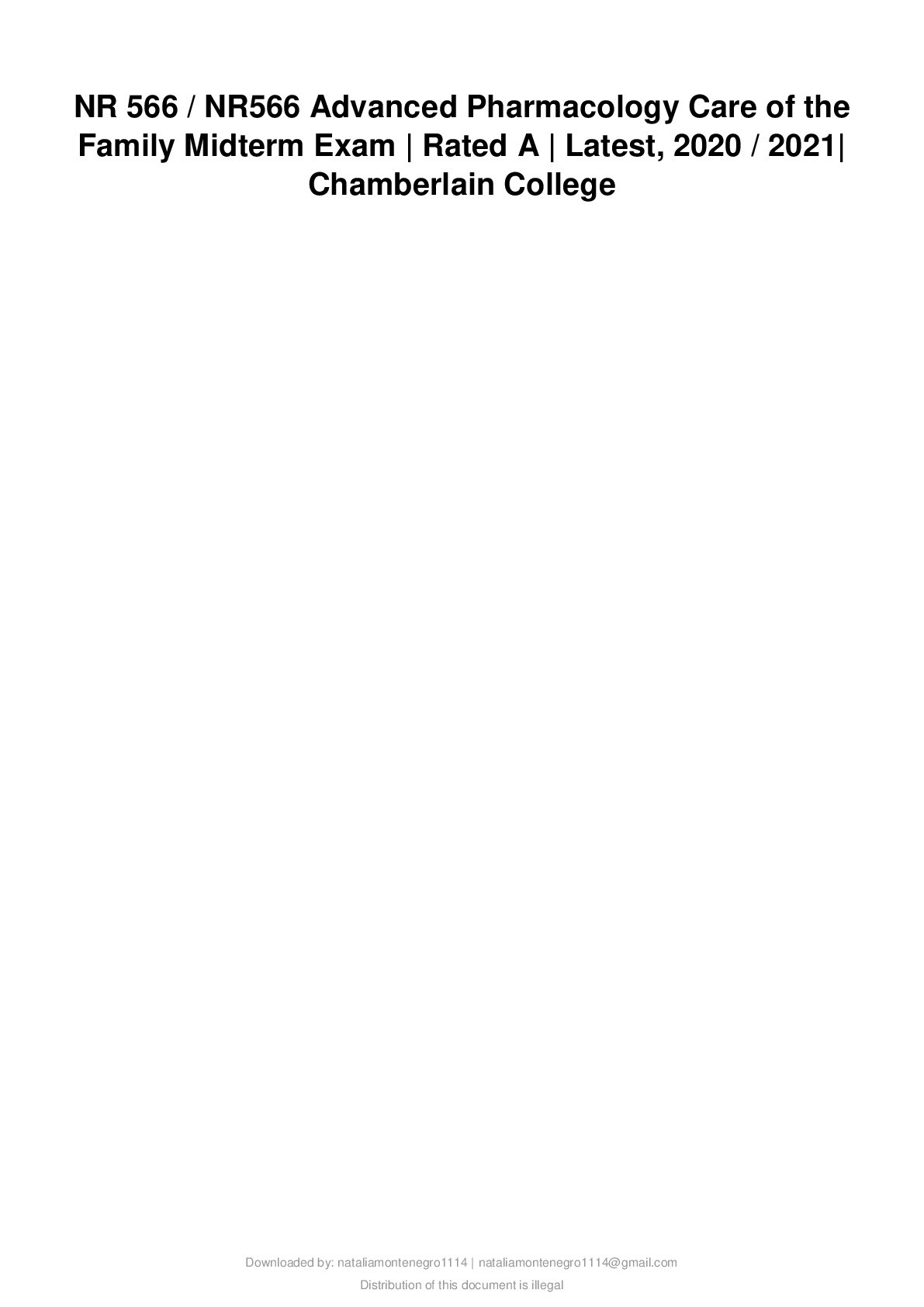All study resources > NR 566 / NR566 Advanced Pharmacology Care of the Family Midterm Exam (Nursing)
NR 566 / NR566 Advanced Pharmacology Care of the Family Midterm Exam
1. Pneumonia goals of treatment
- Return to baseline respiratory status
- Fever resolves in 2 to 4 days
- Leukocytosis resolves by day 4 of treatment
- Chest x-ray may take 4 weeks or more to return
2. Common bacterial pathogens of Adult pneumonia
- S. pneumoniae
- Patients with underlying lung disease
- Nontypeable Haemophilus influenza and Moraxella catarrhalis
- Staph aureus: co-pathog
...[Show More]
1. Pneumonia goals of treatment
- Return to baseline respiratory status
- Fever resolves in 2 to 4 days
- Leukocytosis resolves by day 4 of treatment
- Chest x-ray may take 4 weeks or more to return
2. Common bacterial pathogens of Adult pneumonia
- S. pneumoniae
- Patients with underlying lung disease
- Nontypeable Haemophilus influenza and Moraxella catarrhalis
- Staph aureus: co-pathogen with influenza
- Mycoplasma pneumoniae
- Viral pneumonia
3. Common bacterial pathogens of Adult Community-Acquired Pneumonia
- Consult current treatment guidelines for the most recent treatment guidelines for community acquired pneumonia (CAP)
4. Common bacterial pathogens of CAP in pregnant women
- Main pathogens are S. pneumoniae
- H. influenzae, M. pneumoniae, and viruses
- Macrolides
- Pregnancy category B: erythromycin, azithromycin
- Pregnancy category category C: clarithromycin
- Comorbid conditions or recent antibiotics:
- Beta-lactam plus a macrolide
5. Common pediatric pneumonia pathogens
- S. pneumoniae is the most common cause of bacterial pneumonia in patients of all ages
- Increase in viral pneumonia with PCV7 vaccine
- Infants 4 to 16 weeks
- Consider chlamydia
- Over 5 years through adolescence
- Consider mycoplasma
- Community-acquired methicillin-resistant staphylococcus aureus
- Virus
6. Clinical practice guidelines for treatment of CAP
- Children under age 5 years
- Bacterial pneumonia (S. pneumoniae)
- Amoxicillin: 80 to 90 mg/kg/day
- Ceftriaxone: 50 mg/kg/day until able to take oral antibiotics
- Penicillin allergy: clindamycin or a macrolide
- Infant with suspected chlamydial pneumonia
- Azithromycin 20 mg/kg/day for 3 days OR erythromycin (EryPed) 50 mg/kg for 14 days
- Children 5 Years or Older
- Mycoplasma or other atypical most likely
- Azithromycin: 10 mg/kg on day 1 and 5 mg/kg on days 2 through 5
- Clarithromycin: 15 mg/kg per day in two divided doses (maximum 1 g/day)
- Erythromycin: 40 to 50 mg/kg/day
7. CAP treatment in pregnancy
- abx treatment:
- 1st choice: Erythromycin or azithromycin cat B. or Clarythromycin cat C.
8. Radiologic findings during CAP treatment
- assist in confirming the dx of pneumonia vs other resp disorders such as lung abscess or tuberculosis
9. Treatment of chlamydial pneumonia
- he standard treatment for infants is erythomycin
10. Nicotine patch teaching
- Advise patients to dispose of used nicotine patches out of the reach of children or animals. Enough nicotine is left in a used patch to lead to toxic levels in a child or small animal.
- The transdermal nicotine system, or "patch," provides a slow, cutaneous absorption of nicotine over many hours. The patch is applied to clean, nonhairy skin on the upper body or upper arm when the patient wakes up. Peak nicotine levels occur in 2 to 6 hours (brand-dependent) and then gradually decrease. Once the patch is removed, nicotine levels in the blood reach a nondetectable level in 10 to 12 hours in nonsmokers.
[Show Less]
